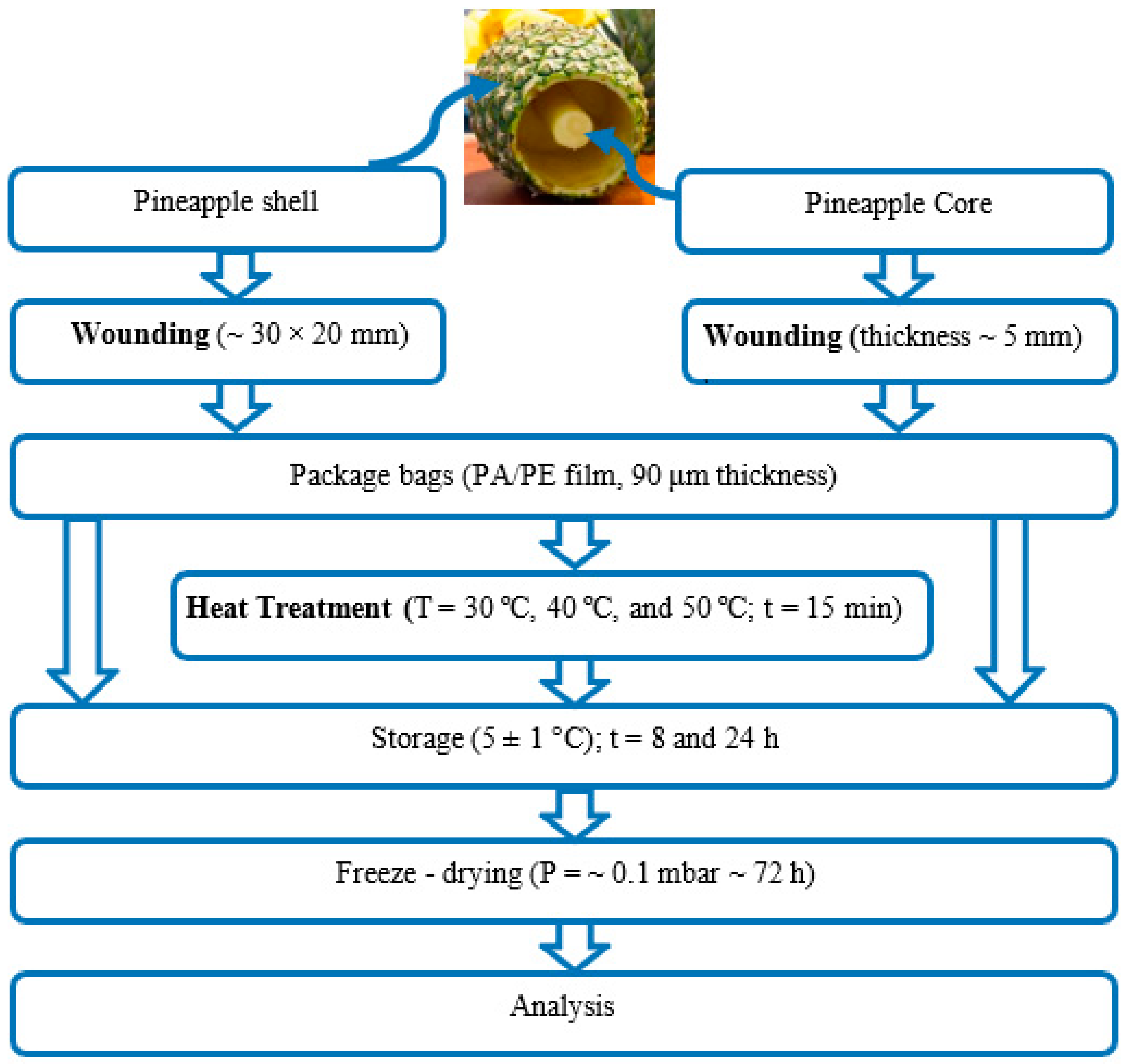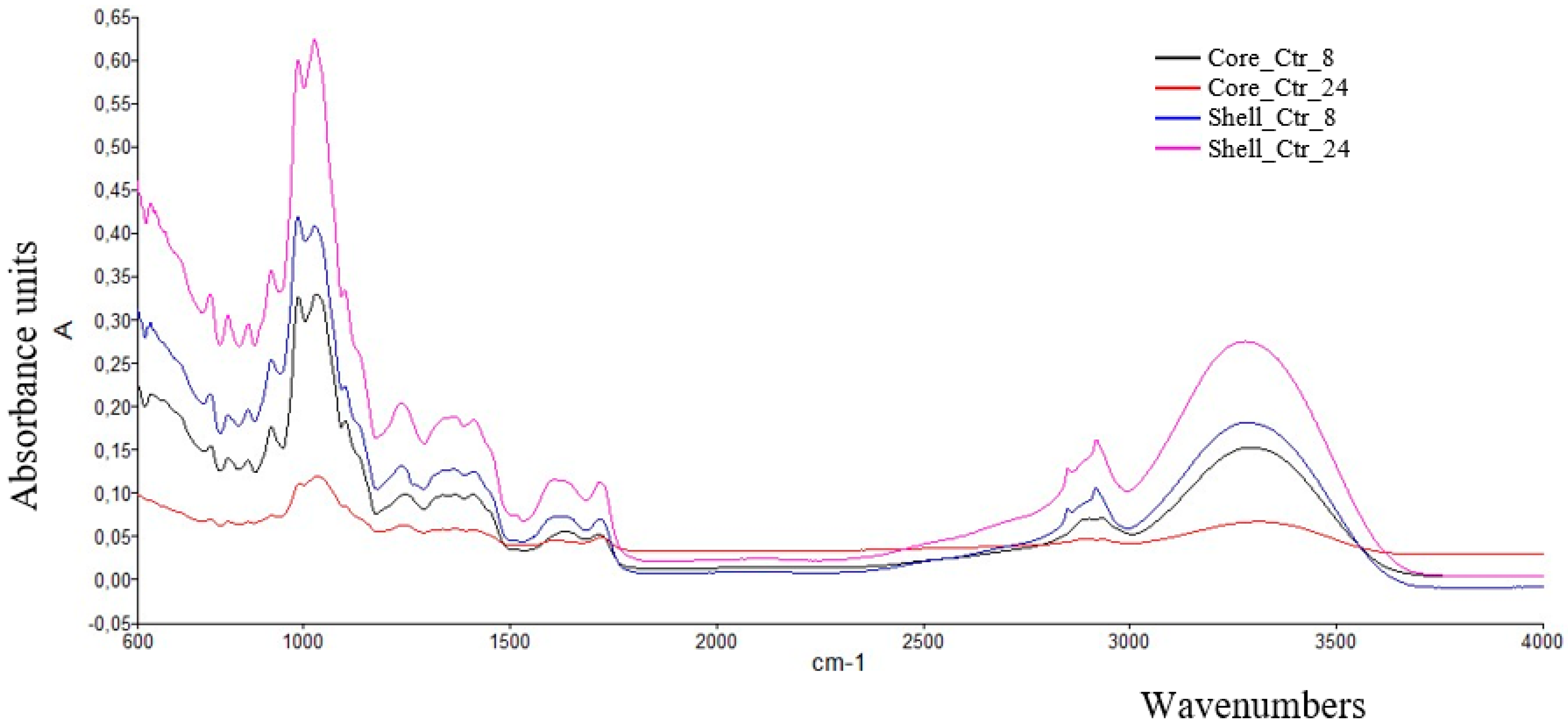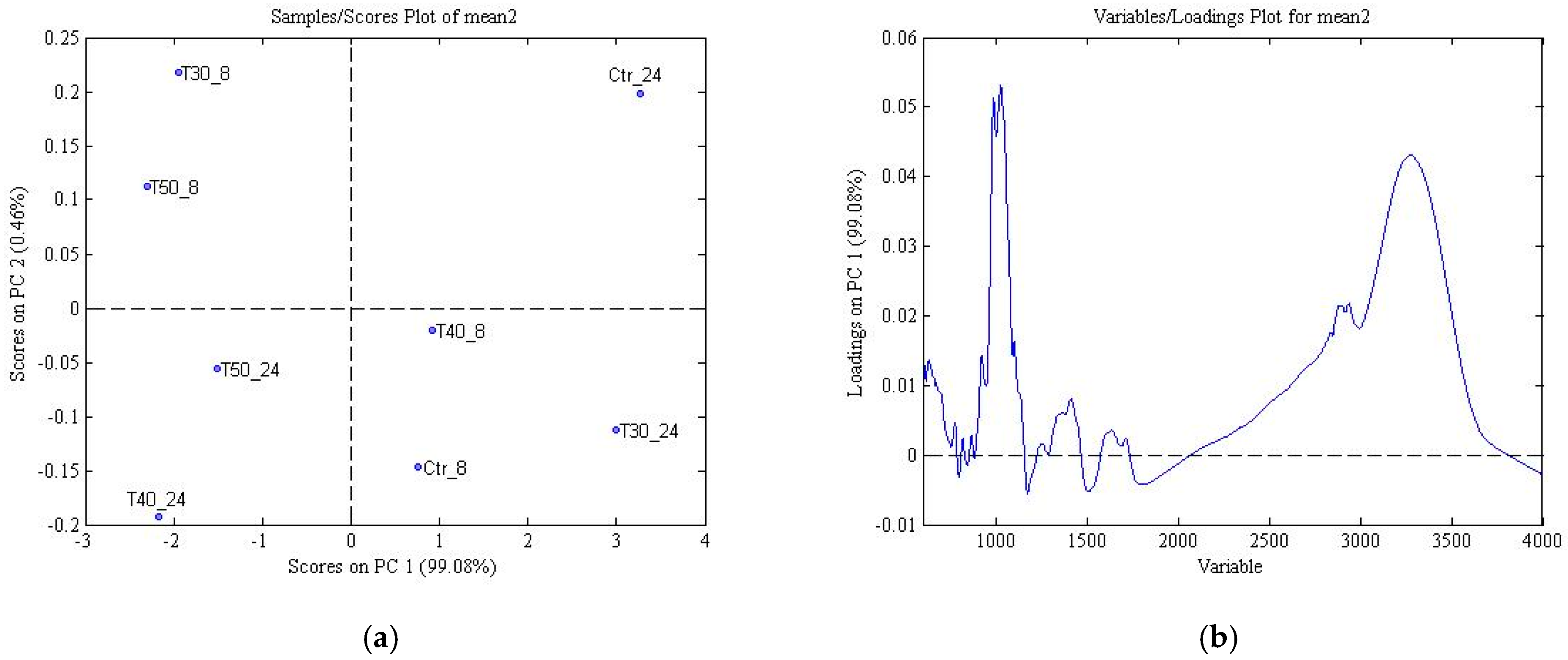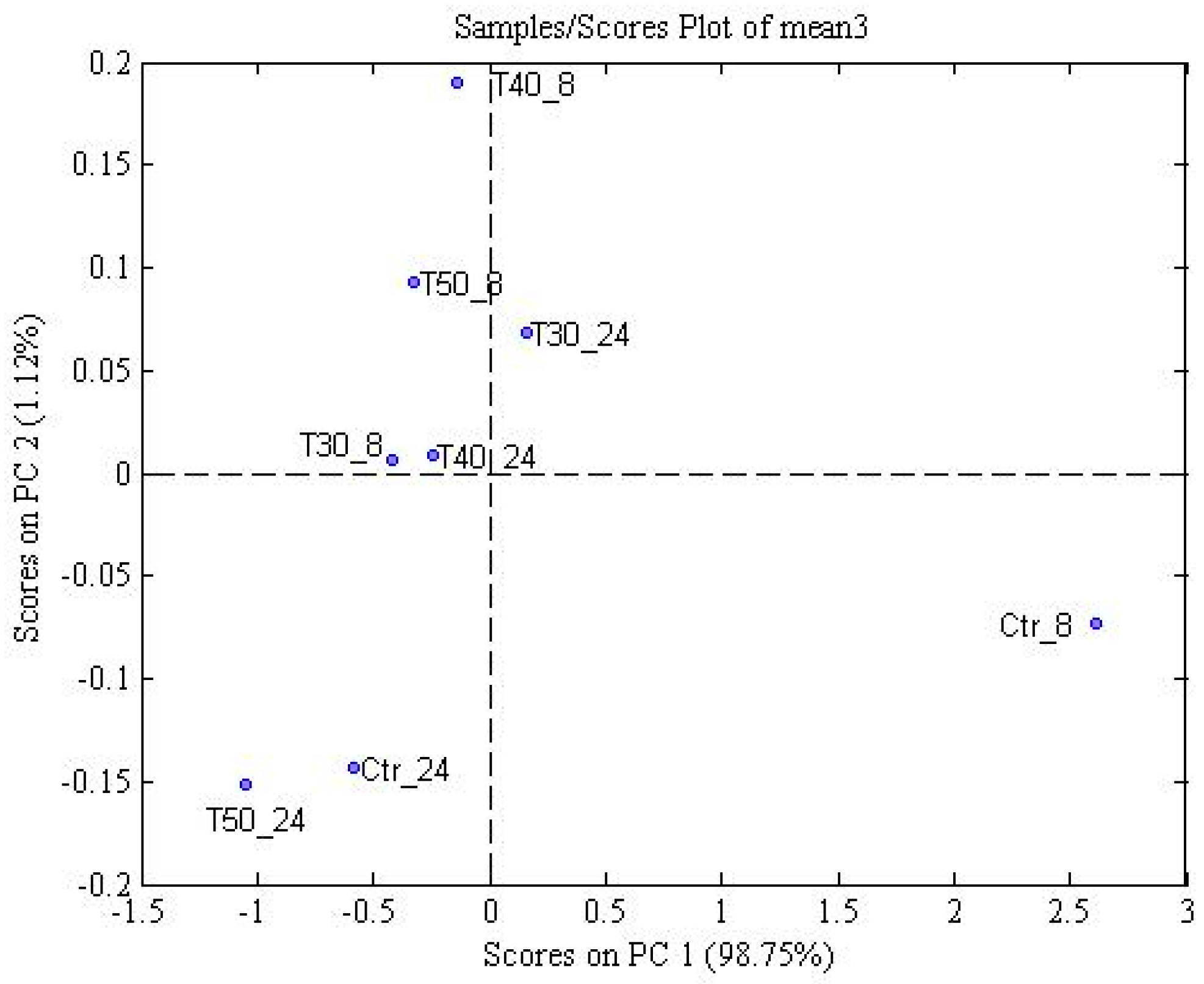Fourier Transform Infrared (FT-IR) Spectroscopy as a Possible Rapid Tool to Evaluate Abiotic Stress Effects on Pineapple By-Products
Abstract
1. Introduction
2. Materials and Methods
2.1. Materials
2.2. Abiotic Stresses
2.3. Analytical Methods
2.3.1. Total Phenolic Content and Antioxidant Capacity
2.3.2. Fourier Transform Infrared Spectroscopy
2.3.3. Statistical Analysis
3. Results and Discussion
3.1. Total Phenolic Content and Antioxidant Capacity
3.1.1. In Pineapple Shell and Core
3.1.2. Wounding Effect in Pineapple Shell and Core
3.1.3. Thermal Treatment Effect in Pineapple Shell and Core
3.2. Fourier Transform Infrared Spectroscopy
4. Conclusions
Author Contributions
Funding
Acknowledgments
Conflicts of Interest
References
- Davis, R.; Mauer, L.J. Fourier Transform Infrared (FT-IR) Spectroscopy: A Rapid Tool for Detection and Analysis of Foodborne Pathogenic Bacteria. Curr. Res. Technol. Educ. Top. Appl. Microbiol. Microb. Biotechnol. 2010, 2, 1582–1594. [Google Scholar]
- Smith, B. Fundamentals of Fourier Transform Infrared Spectroscopy, Second Edition; CRC Press: Boca Raton, FL, USA, 2011; ISBN 978-1-4200-6929-7. [Google Scholar]
- Felizardo, P.; Baptista, P.; Uva, M.S.; Menezes, J.C.; Neiva Correia, M.J. Monitoring biodiesel fuel quality by near infrared spectroscopy. J. Near Infrared Spectrosc. 2007, 15, 97–105. [Google Scholar] [CrossRef]
- Beirão-Da-Costa, S.; Steiner, A.; Correia, L.; Leitão, E.; Empis, J.; Moldão-Martins, M. Influence of moderate heat pre-treatments on physical and chemical characteristics of kiwifruit slices. Eur. Food Res. Technol. 2008, 226, 641–651. [Google Scholar] [CrossRef][Green Version]
- Kareem, S.O.; Akpan, I.; Alebiowu, O.O. Production of citric acid by Aspergillus niger using pineapple waste. Malays. J. Microbiol. 2010, 6, 161–165. [Google Scholar]
- Larrauri, J.A.; Rupérez, P.; Saura Calixto, F. Pineapple Shell as a Source of Dietary Fiber with Associated Polyphenols. J. Agric. Food Chem. 1997, 45, 4028–4031. [Google Scholar] [CrossRef]
- Hajar, N.; Zainal, S.; Nadzirah, K.Z.; Roha, A.M.S.; Atikah, O.; Elida, T.Z.M.T. Physicochemical Properties Analysis of Three Indexes Pineapple (Ananas Comosus) Peel Extract Variety N36. APCBEE Procedia 2012, 4, 115–121. [Google Scholar] [CrossRef]
- Abdullah Solid And Liquid Pineapple Waste Utilization for Lactic Acid Fermentation. Reaktor 2007, 11, 50–52.
- Balasundram, N.; Sundram, K.; Samman, S. Phenolic compounds in plants and agri-industrial by-products: Antioxidant activity, occurrence, and potential uses. Food Chem. 2006, 99, 191–203. [Google Scholar] [CrossRef]
- Peschel, W.; Sánchez-Rabaneda, F.; Diekmann, W.; Plescher, A.; Gartzía, I.; Jiménez, D.; Lamuela-Raventós, R.; Buxaderas, S.; Codina, C. An industrial approach in the search of natural antioxidants from vegetable and fruit wastes. Food Chem. 2006, 97, 137–150. [Google Scholar] [CrossRef]
- Freitas, A.; Moldão-Martins, M.; Costa, H.S.; Albuquerque, T.G.; Valente, A.; Sanches-Silva, A. Effect of UV-C radiation on bioactive compounds of pineapple (Ananas comosus L. Merr.) by-products. J. Sci. Food Agric. 2015, 95, 44–52. [Google Scholar] [CrossRef]
- Cisneros-Zevallos, L. The Use of Controlled Postharvest Abiotic Stresses as a Tool for Enhancing the Nutraceutical Content and Adding-Value of Fresh Fruits and Vegetables. J. Food Sci. 2003, 68, 1560–1565. [Google Scholar] [CrossRef]
- Ke, D.; Saltveit, M.E. Wound-induced ethylene production, phenolic metabolism and susceptibility to russet spotting in iceberg lettuce. Physiol. Plant. 1989, 76, 412–418. [Google Scholar] [CrossRef]
- Saltveit, M.E. Wound induced changes in phenolic metabolism and tissue browning are altered by heat shock. Postharvest Biol. Technol. 2000, 21, 61–69. [Google Scholar] [CrossRef]
- Surjadinata, B.B.; Cisneros-Zevallos, L. Modeling Wound-induced Respiration of Fresh-cut Carrots (Daucus carota L.). J. Food Sci. 2003, 68, 2735–2740. [Google Scholar] [CrossRef]
- Alegria, C.; Pinheiro, J.; Gonçalves, E.M.; Fernandes, I.; Moldão, M.; Abreu, M. Evaluation of a pre-cut heat treatment as an alternative to chlorine in minimally processed shredded carrot. Innov. Food Sci. Emerg. Technol. 2010, 11, 155–161. [Google Scholar] [CrossRef]
- Alegria, C.; Pinheiro, J.; Duthoit, M.; Gonçalves, E.M.; Moldão-Martins, M.; Abreu, M. Fresh-cut carrot (cv. Nantes) quality as affected by abiotic stress (heat shock and UV-C irradiation) pre-treatments. LWT Food Sci. Technol. 2012, 48, 197–203. [Google Scholar] [CrossRef]
- Jantasee, A.; Thumanu, K.; Muangsan, N.; Leeanansaksiri, W.; Maensiri, D. Fourier Transform Infrared Spectroscopy for Antioxidant Capacity Determination in Colored Glutinous Rice. Food Anal. Methods 2014, 7, 389–399. [Google Scholar] [CrossRef]
- Cozzolino, D. Infrared Spectroscopy as a Versatile Analytical Tool for the Quantitative Determination of Antioxidants in Agricultural Products, Foods and Plants. Antioxidants 2015, 4, 482–497. [Google Scholar] [CrossRef]
- Park, Y.S.; Heo, B.G.; Ham, K.S.; Kang, S.G.; Park, Y.K.; Neirovski, A.; Tashma, Z.; Gorinstein, S.; Leontowicz, H.; Leontowicz, M. Analytical determination of bioactive compounds as an indication of fruit quality. J. AOAC Int. 2012, 95, 1725–1732. [Google Scholar] [CrossRef]
- Lu, X.; Ross, C.F.; Powers, J.R.; Aston, D.E.; Rasco, B.A. Determination of total phenolic content and antioxidant activity of garlic (Allium sativum) and elephant garlic (Allium ampeloprasum) by attenuated total reflectance-fourier transformed infrared spectroscopy. J. Agric. Food Chem. 2011, 59, 5215–5221. [Google Scholar] [CrossRef]
- Gorinstein, S.; Haruenkit, R.; Poovarodom, S.; Vearasilp, S.; Ruamsuke, P.; Namiesnik, J.; Leontowicz, M.; Leontowicz, H.; Suhaj, M.; Sheng, G.P. Some analytical assays for the determination of bioactivity of exotic fruits. Phytochem. Anal. 2010, 21, 355–362. [Google Scholar] [CrossRef] [PubMed]
- Lam, H.S.; Proctor, A.; Howard, L.; Cho, M.J. Rapid Fruit Extracts Antioxidant Capacity Determination by Fourier Transform Infrared Spectroscopy. J. Food Sci. 2006, 70, C545–C549. [Google Scholar] [CrossRef]
- Swain, T.; Hillis, W.E. The phenolic constituents of Prunus domestica. I.—The quantitative analysis of phenolic constituents. J. Sci. Food Agric. 1959, 10, 63–68. [Google Scholar] [CrossRef]
- Heredia, J.B.; Cisneros-Zevallos, L. The effects of exogenous ethylene and methyl jasmonate on the accumulation of phenolic antioxidants in selected whole and wounded fresh produce. Food Chem. 2009, 115, 1500–1508. [Google Scholar] [CrossRef]
- Brand-Williams, W.; Cuvelier, M.E.; Berset, C. Use of a free radical method to evaluate antioxidant activity. LWT Food Sci. Technol. 1995, 28, 25–30. [Google Scholar] [CrossRef]
- Benzie, I.F.F.; Strain, J.J. The ferric reducing ability of plasma (FRAP) as a measure of “antioxidant power”: The FRAP assay. Anal. Biochem. 1996, 239, 70–76. [Google Scholar] [CrossRef] [PubMed]
- Re, R.; Pellegrini, N.; Proteggente, A.; Pannala, A.; Yang, M.; Rice-Evans, C. Antioxidant activity applying an improved ABTS radical cation decolorization assay. Free Radic. Biol. Med. 1999, 26, 1231–1237. [Google Scholar] [CrossRef]
- Rufino, M.S.M.; Alves, R.E.; Sousa De Brito, E.; Maia De Morais, S.; Goes Sampaio, C.; Pérez-Jiménez, J.; Saura-Calixto, F.D. Metodologia Científica: Determinação da Atividade Antioxidante Total em Frutas pela Captura do Radical Livre ABTS +; Embrapa Agroindústria Tropical: Fortaleza, Brazil, 2007. [Google Scholar]
- StatSoft STATISTICA (Data Analysis SoftwareSystem); StatSoft: Tulsa, OK, USA, 2007.
- Baptista, P.; Felizardo, P.; Menezes, J.C.; Neiva Correia, M.J. Multivariate near infrared spectroscopy models for predicting the iodine value, CFPP, kinematic viscosity at 40 °C and density at 15 °C of biodiesel. Talanta 2008, 77, 144–151. [Google Scholar] [CrossRef]
- Alegria, C.; Gonçalves, E.M.; Moldão-Martins, M.; Cisneros-Zevallos, L.; Abreu, M. Peel removal improves quality without antioxidant loss, through wound-induced phenolic biosynthesis in shredded carrot. Postharvest Biol. Technol. 2016, 120, 232–239. [Google Scholar] [CrossRef]
- Stuart, B.H. Spectral Analysis. In Infrared Spectroscopy: Fundamentals and Applications; John Wiley & Sons, Ltd.: Chichester, UK, 2005; ISBN 9780470011140. [Google Scholar]
- Stuart, B.H. Industrial and Environmental Applications. In Infrared Spectroscopy: Fundamentals and Applications; John Wiley & Sons, Ltd.: Chichester, UK, 2005; pp. 167–186. ISBN 9780470011140. [Google Scholar]
- Manrique, G.D.; Lajolo, F.M. FT-IR spectroscopy as a tool for measuring degree of methyl esterification in pectins isolated from ripening papaya fruit. Postharvest Biol. Technol. 2002, 25, 99–107. [Google Scholar] [CrossRef]
- Leopold, L.F.; Leopold, N.; Diehl, H.A.; Socaciu, C. Quantification of carbohydrates in fruit juices using FTIR spectroscopy and multivariate analysis. J. Spectrosc. 2011, 26, 93–104. [Google Scholar] [CrossRef]
- Bureau, S.; Ruiz, D.; Reich, M.; Gouble, B.; Bertrand, D.; Audergon, J.M.; Renard, C.M.G.C. Application of ATR-FTIR for a rapid and simultaneous determination of sugars and organic acids in apricot fruit. Food Chem. 2009, 115, 1133–1140. [Google Scholar] [CrossRef]
- Mohamed, G.F.; Shaheen, M.S.; Khalil, S.K.H.; Hussein, A.M.S.; Kamil, M.M. Application of FT-IR Spectroscopy for Rapid and Simultaneous Quality Determination of Some Fruit Products. Nat. Sci. 2011, 9, 21–31. [Google Scholar]




| Raw Material | Sample | TPC (mgGAE.g−1 dry weight) | Antioxidant Capacity (μmol Trolox.g−1 dry weight) | ||
|---|---|---|---|---|---|
| DPPH | FRAP | ABTS | |||
| Shell pineapple | Ctr_0 | 65.75 ± 1.40 b | 21.56 ± 0.78 ac | 41.37 ± 1.73 ac | 26.10 ± 1.54 ad |
| Ctr_8 | 79.72 ± 2.87 e | 33.59 ± 3.81 ef | 52.72 ± 3.05 de | 33.54 ± 2.27 ce | |
| Ctr_24 | 84.83 ± 2.01 f | 38.70 ± 3.38 f | 63.71 ± 2.96 f | 38.64 ± 2.24 f | |
| T30_8 | 69.08 ± 1.70 bc | 26.08 ± 1.25 ad | 46.45 ± 1.55 b | 30.99 ± 1.65 bc | |
| T40_8 | 75.76 ± 1.75 d | 25.02 ± 3.47 a | 48.13 ± 3.05 bd | 29.87 ± 2.54 bc | |
| T50_8 | 57.05 ± 2.39 a | 16.85 ± 1.33 bc | 38.15 ± 2.03 a | 24.06 ± 1.12 a | |
| T30_24 | 78.80 ± 2.28 de | 31.22 ± 3.81 de | 55.26 ± 3.51 e | 34.72 ± 2.56 e | |
| T40_24 | 70.28 ± 1.89 c | 22.75 ± 1.98 a | 45.56 ± 1.89 bc | 28.25 ± 1.73 bd | |
| T50_24 | 57.01 ± 1.57 a | 14.91 ± 2.78 b | 39.65 ± 1.54 a | 24.25 ± 1.58 a | |
| Core pineapple | Ctr_0 | 59.89 ± 1.86 D | 24.06 ± 1.24 A | 31.18 ± 1.98 C | 22.34 ± 1.19 E |
| Ctr_8 | 67.14 ± 2.58 A | 25.01 ± 1.48 AB | 38.06 ± 1.17 B | 26.64 ± 0.66 ABC | |
| Ctr_24 | 65.07 ± 1.83 AB | 22.84 ± 1.07 AD | 38.03 ± 1.12 B | 25.67 ± 0.96 ABD | |
| T30_8 | 70.92 ± 2.09 C | 28.60 ± 1.20 C | 42.62 ± 1.90 A | 31.94 ± 1.78 F | |
| T40_8 | 73.49 ± 1.91 C | 26.99 ± 1.60 BC | 45.85 ± 1.63 D | 27.05 ± 1.11 ABC | |
| T50_8 | 71.94 ± 1.62 C | 24.50 ± 0.99 AB | 41.14 ± 1.54 A | 25.17 ± 1.28 AD | |
| T30_24 | 65.05 ± 1.37 AB | 23.87 ± 1.38 A | 41.10 ± 1.08 A | 23.68 ± 0.84 DE | |
| T40_24 | 62.01 ± 1.12 BD | 29.48 ± 1.78 C | 40.03 ± 1.03 AB | 28.15 ± 1.09 C | |
| T50_24 | 65.99 ± 1.72 A | 20.52 ± 1.98 D | 41.42 ± 1.03 A | 27.81 ± 1.06 BC | |
© 2019 by the authors. Licensee MDPI, Basel, Switzerland. This article is an open access article distributed under the terms and conditions of the Creative Commons Attribution (CC BY) license (http://creativecommons.org/licenses/by/4.0/).
Share and Cite
Santos, D.I.; Neiva Correia, M.J.; Mateus, M.M.; Saraiva, J.A.; Vicente, A.A.; Moldão, M. Fourier Transform Infrared (FT-IR) Spectroscopy as a Possible Rapid Tool to Evaluate Abiotic Stress Effects on Pineapple By-Products. Appl. Sci. 2019, 9, 4141. https://doi.org/10.3390/app9194141
Santos DI, Neiva Correia MJ, Mateus MM, Saraiva JA, Vicente AA, Moldão M. Fourier Transform Infrared (FT-IR) Spectroscopy as a Possible Rapid Tool to Evaluate Abiotic Stress Effects on Pineapple By-Products. Applied Sciences. 2019; 9(19):4141. https://doi.org/10.3390/app9194141
Chicago/Turabian StyleSantos, Diana I., M. Joana Neiva Correia, Maria Margarida Mateus, Jorge A. Saraiva, António A. Vicente, and Margarida Moldão. 2019. "Fourier Transform Infrared (FT-IR) Spectroscopy as a Possible Rapid Tool to Evaluate Abiotic Stress Effects on Pineapple By-Products" Applied Sciences 9, no. 19: 4141. https://doi.org/10.3390/app9194141
APA StyleSantos, D. I., Neiva Correia, M. J., Mateus, M. M., Saraiva, J. A., Vicente, A. A., & Moldão, M. (2019). Fourier Transform Infrared (FT-IR) Spectroscopy as a Possible Rapid Tool to Evaluate Abiotic Stress Effects on Pineapple By-Products. Applied Sciences, 9(19), 4141. https://doi.org/10.3390/app9194141






